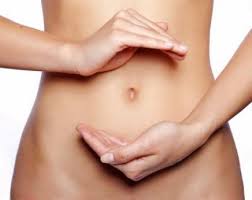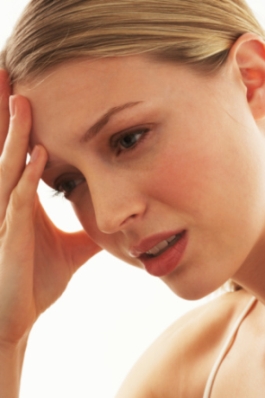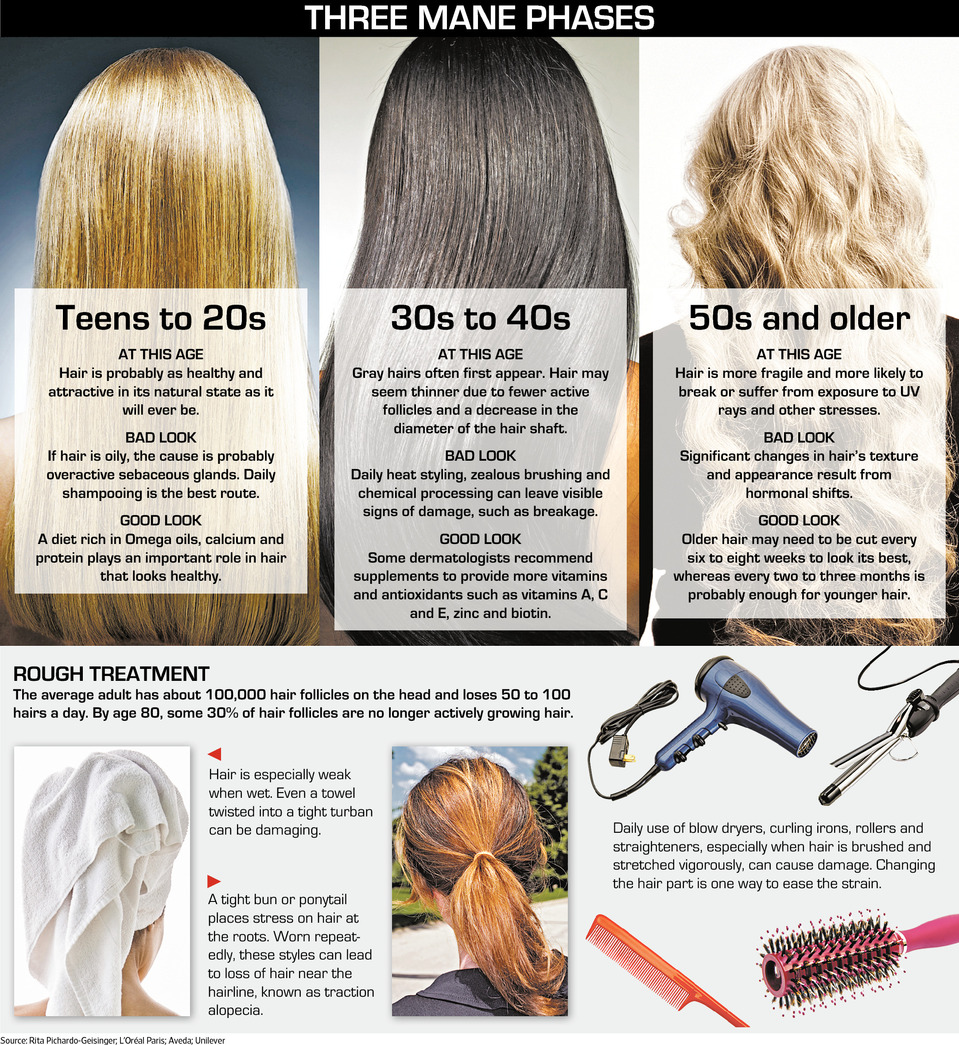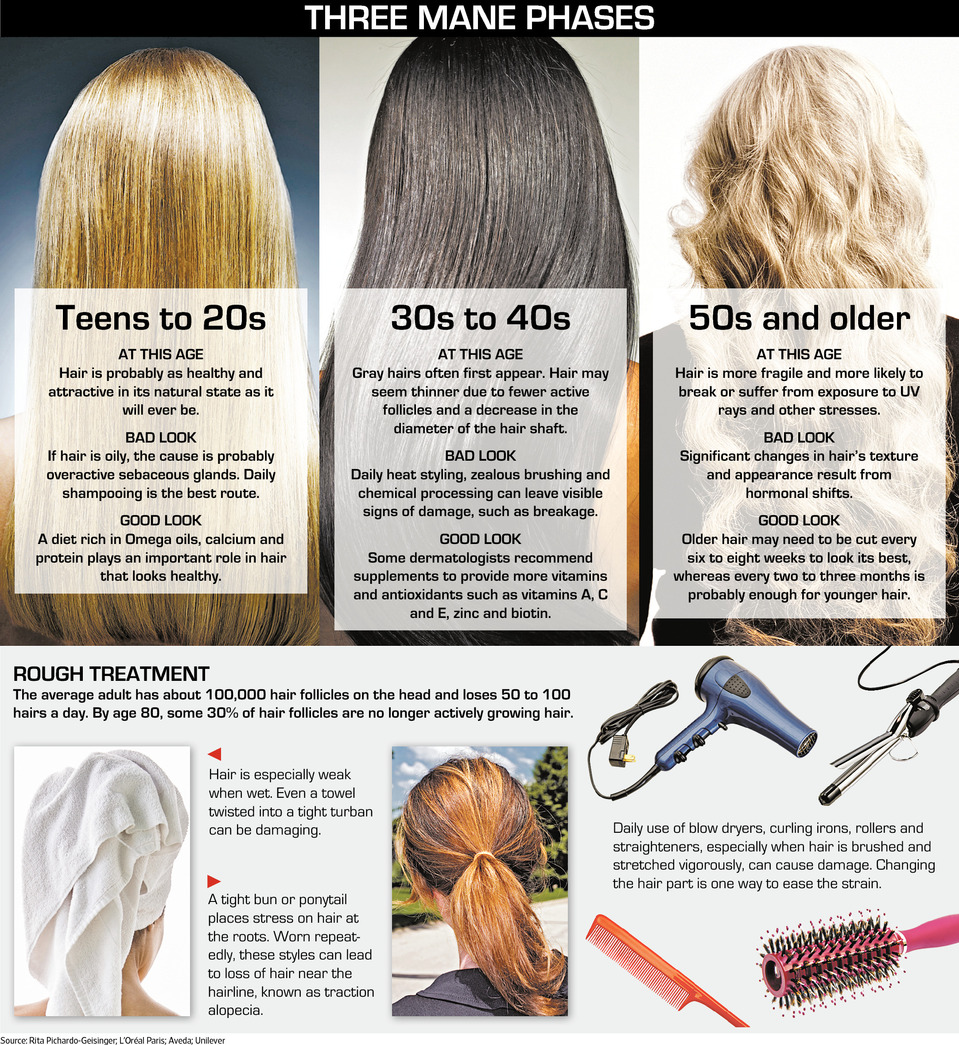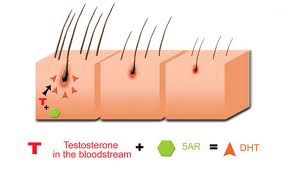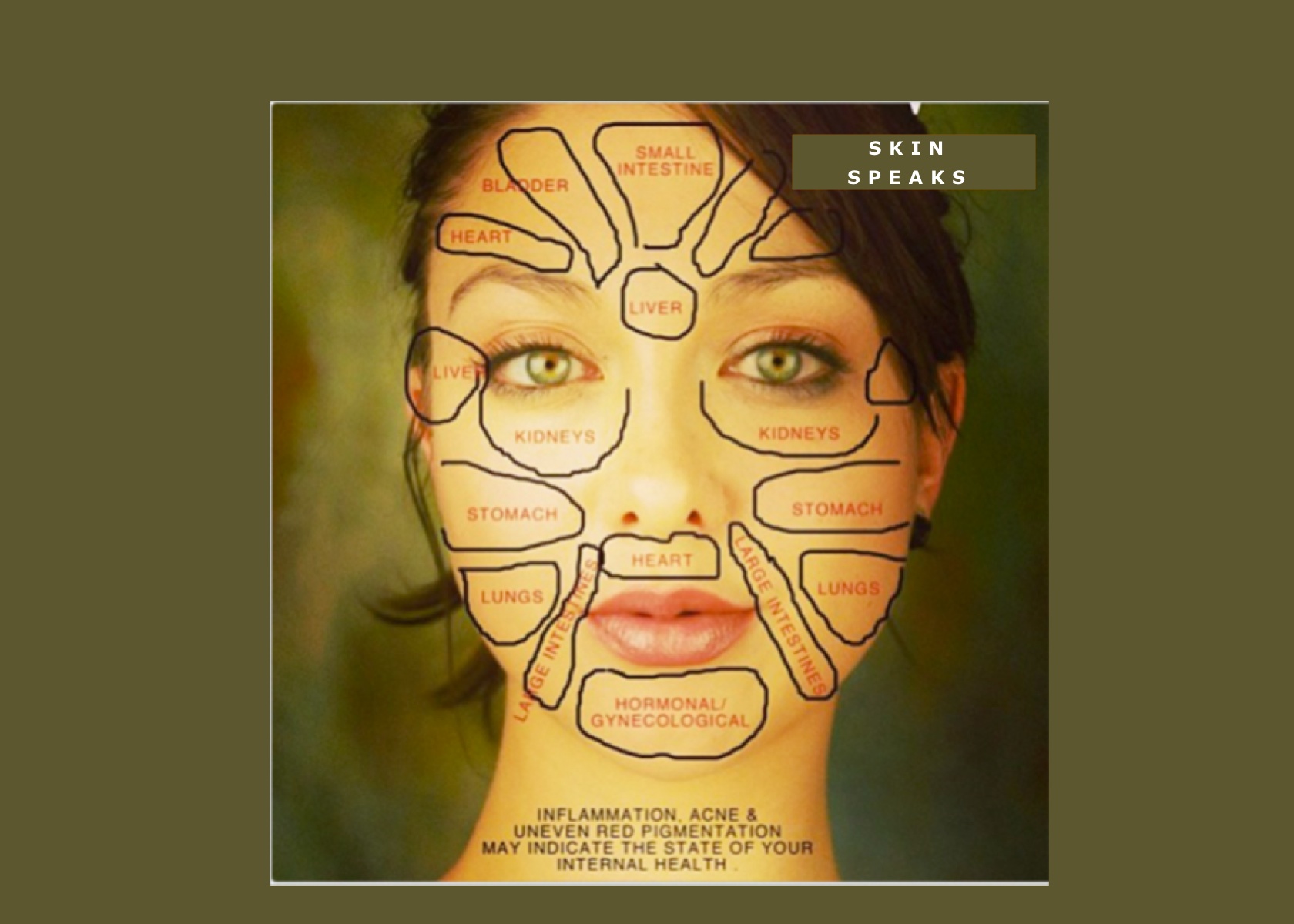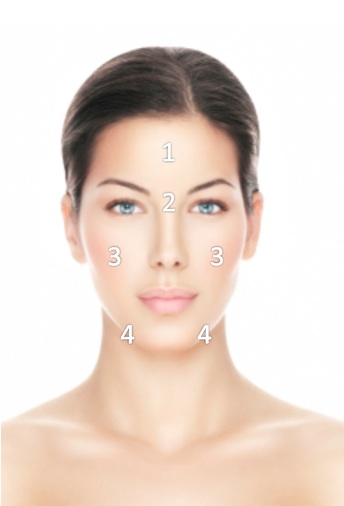With a love in biochemistry and the passion of a salon owner, our hair says a lot more about us than how closely we follow the latest styles. In fact, the health of our hair and scalp can be a major tip-off to a wide variety of health conditions.
Our hair responds to stress, both the physical stressors of disease and underlying health issues, and psychological stress.
Here are 8 RED FLAGS that tell you it's time to pay more attention to the health of your hair -- and "Beautiful Health."
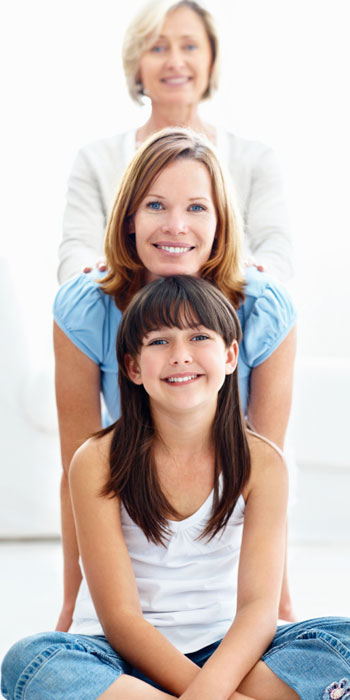
Red flag #1: Dry, limp, thin-feeling hair
What it means: Many factors can lead to over-dry hair, including hair dyes, hair blowers, and swimming in chlorinated water. But a significant change in texture that leaves hair feeling finer, with less body, can be an indicator of an underactive thyroid, known as hypothyroidism. Some people conclude that their hair is thinning because it feels as if there's less of it, but the thinning is due more to the texture of the hair itself becoming finer and weaker than to individual hairs falling out (though that happens too).
More clues: Other signs of hypothyroidism include fatigue, weight gain, slow heart rate, and feeling cold all the time, says Raphael Darvish, a dermatologist in Brentwood, California. In some cases, the eyebrows also thin and fall out. A telltale sign: when the outermost third of the eyebrow thins or disappears.
What to do: Report your concerns to your doctor and ask him or her to check your levels of thyroid hormone. The most common blood tests measure the levels of thyroid-stimulating hormone (TSH) and T4. It's also important to keep a list of your symptoms -- all of them.
"A doctor's visit is best to work up this problem; he or she may choose to do a thyroid ultrasound and a blood test in addition to an examination," says Darvish.
Red flag #2: Scaly or crusty patches on the scalp, often starting at the hairline
What it means: When a thick crust forms on the scalp, this usually indicates psoriasis, which can be distinguished from other dandruff-like skin conditions by the presence of a thickening, scab-like surface, says Lawrence Greene, MD, a spokesperson for the National Psoriasis Foundation. Psoriasis is the most common of all the autoimmune diseases and occurs when the skin goes into overdrive, sending out faulty signals that speed up the turnover and growth of skin cells.
More clues: Psoriasis, which affects nearly 7.5 million Americans, often occurs in concert with other autoimmune diseases such as Crohn's disease, lupus, and rheumatoid arthritis. If you have another autoimmune disorder, it's that much more likely you'll develop psoriasis. In turn, the discovery that you have psoriasis should put you on the alert for more serious conditions. Up to 30 percent of people with psoriasis develop a condition called psoriatic arthritis, which causes painful swelling of the joints.
What to do: There's a long list of ingredients that help relieve psoriasis, and treatment is often a process of trial and error. Topical treatments include shampoos containing coal tar or salicylic acid, and creams or ointments containing zinc and aloe vera. Hydrocortisone cream works to relieve inflammation. Prescription creams include vitamin D, vitamin A, and anthralin. Many patients also have great success treating the scalp with UV light therapy, and systemic medications such as cyclosporine work better for some people than topical medications.
It's a good idea to see a dermatologist for help sorting out the various treatments, rather than trying to do it on your own. One thing to keep in mind: Psoriasis puts you at increased risk of diabetes, heart disease, hypertension, certain types of cancer, metabolic syndrome, obesity, and
Red flag #3: Thinning hair over the whole head
What it means: It's normal to shed approximately 100 to 150 hairs a day, the result of the body's natural turnover. It's when you notice considerably more hairs in your brush or on the towel after you shampoo -- or when hair appears to be coming out in clumps -- that it's time for concern. One common cause: a sudden psychological or physical stressor, such as a divorce or job loss. Another: having a high fever from the flu or an infection. Diabetes can also cause hair to thin or start to fall out suddenly; some diabetes experts say sudden hair thinning or hair loss should be considered an early warning sign that diabetes is affecting hormone levels.
A number of medications also cause hair loss as a side effect. These include birth control pills, along with lithium and Depakote, two of the most common treatments for bipolar disorder. More rarely, tricyclic antidepressants such as Prozac, and levothyroid -- used to treat hypothyroidism -- cause thinning hair. Hormonal changes can also cause hair to thin, which is why both pregnancy and perimenopause are well known for causing hair to fall out, while polycystic ovary disease can cause both hair loss and overgrowth of hair, depending on how the hormones go out of balance. Thyroid disease, especially hypothyroidism, is one of the most common causes of hair loss.
More clues: Check for tiny white bumps at the roots of the hair; their presence suggests that this is temporary hair loss rather than male/female pattern baldness, says Chicago dermatologist Victoria Barbosa. Any medication that interferes with hormones can cause this type of hair loss; the list includes birth control pills, Accutane for acne, and prednisone and anabolic steroids. Physical stressors that can lead to temporary hair loss include iron deficiency anemia and protein deficiency; these are particularly common in those who've suffered from eating disorders.
What to do: If you have what experts call temporary hair loss -- to distinguish from hereditary hair loss, which is likely to be permanent -- you'll need to discontinue the medication or treat the underlying condition that's causing the problem. It can also help to take supplemental biotin, which has been shown to strengthen and thicken hair and fingernails, says Barbosa.
And while vitamin D deficiency hasn't been pinpointed as a cause of hair loss, research has demonstrated that taking vitamin D helps grow the hair back. "We don't know how vitamin D contributes to hair loss, but we do know the hair follicles need good levels of vitamin D to recover," Barbosa says. Recommended dose: 2000 IUs of vitamin D3 daily. In addition, talk to your doctor about getting your blood levels of iron checked for anemia, and take iron if needed.
Red flag #4: Overall hair loss that appears permanent, often following traditional pattern baldness
What it means: Both women and men are subject to what's formally known as androgenetic and androgenic alopecia. It's usually caused by a change in the pattern of the sex hormones, but diseases and other underlying conditions can cause this type of hair loss by affecting the hormones. In women, a derivative of testosterone is often the culprit, shrinking and eventually killing off hair follicles. Traditionally known as "male pattern baldness," this type of hair loss is often hereditary and is typically permanent if not treated with medication, says Larry Shapiro, a dermatologist and hair surgeon in Palm Beach, Florida.
Men's hair loss nearly always follows a pattern of thinning along the hairline, at the temples, and in the back of the scalp. Some women's hair loss also follows this pattern, but more typically women experience thinning over the entire head.
Diabetes also can cause or contribute to hair loss. Over time, diabetes often leads to circulatory problems; as a result, the hair follicles don't get adequate nutrients and can't produce new hairs. Hair follicles can eventually die from lack of nutrition, causing permanent hair loss.
More clues: Certain underlying conditions can cause this type of hair loss by altering hormones; these include thyroid disease (both overactive and underactive thyroid) and autoimmune disease, Shapiro says. Many drugs taken long-term to control chronic conditions can have a side effect, in some people, of causing or contributing to hair loss. They include beta blockers such as propranolol and atenolol, anticoagulants like warfarin, and many drugs used to control arthritis, Parkinson's disease, and other conditions.
What to do: If you suspect a medication is causing or exacerbating your hair loss, talk to your doctor about whether an alternative is available that's less likely to have that side effect. (But don't just stop taking your medicine.) Minoxidil, the generic name for the drug marketed as Rogaine, is the primary proven method of treating androgenic hair loss. It works by blocking the action of the hormones at the hair follicle. It's now available over the counter, so you don't have to have a prescription, and it's sold in male and female versions.
Some women find that taking estrogen helps with hormonally triggered hair loss.
Red flag #5: Dry, brittle hair that breaks off easily
What it means: When individual hairs litter your pillow in the morning, this typically indicates breakage rather than hair falling out from the follicle, says Chicago dermatologist Victoria Barbosa. Breakage is most frequently the result of hair becoming over-brittle from chemical processing or dyeing. "Bleaching, straightening, and other chemical processing techniques strip the cuticle to let the chemicals in, which makes the hair shaft more fragile," Barbosa explains.
However, certain health conditions also lead to brittle, fragile hair. Among them: Cushing's syndrome, a disorder of the adrenal glands that causes excess production of the hormone cortisol. A condition called hypoparathyroidism, usually either hereditary or the result of injury to the parathyroid glands during head and neck surgery, can also cause dry, brittle hair. Overly low levels of parathyroid hormone cause blood levels of calcium to fall and phosphorus to rise, leading to fragile dry hair, scaly skin, and more serious symptoms such as muscle cramps and even seizures.
More clues: If the cause of your dry, brittle hair is an underlying health condition, you'll likely notice additional symptoms, such as dry, flaky skin. Overly dry hair also can signify that your diet is lacking in omega-3 fatty acids, which are found in salmon and fish oil, as well as many nuts and seeds, particularly flaxseed.
What to do: No matter what the cause of your dry, brittle hair, minimizing heat and chemical treatment are necessary for it to get healthy again. If an underlying condition is throwing your hormones out of whack and in turn affecting your hair, talk to your doctor. The symptoms of hypoparathyroidism, for example, are often reduced or eliminated with supplemental vitamin D and calcium.
Next, deep condition your hair to restore it to health. Hair oils can help restore flexibility to the hair shaft, Barbosa says; look for products made with natural oils such as coconut and avocado oil, which penetrate the cuticle, rather than synthetic oils made from petrolatum, which merely coat the hair. Take fish oil supplements to renourish your hair. And minimize breakage while you sleep by replacing cotton pillowcases, which tend to catch and pull at hair, with satin pillowcases, which are smoother.
Red Flag #6: Hair falling out in small, circular patches
What it means: The body's immune response turns on the hair follicles themselves, shrinking them and causing hair to fall out entirely in small, typically round patches. This kind of hair loss -- which experts call alopecia areata -- can also occur at the temples or at the part line. Diabetes can trigger the onset of such hair loss in some people. And it can continue to spread; in extreme cases, sufferers lose all their hair or lose hair over their entire body.
More clues: Alopecia areata can also cause the eyebrows or eyelashes to fall out, which in addition to the circular pattern can distinguish it from other types of hair loss. Alopecia areata is an autoimmune condition and has been shown to be more common in families with a tendency toward other autoimmune diseases, such as rheumatoid arthritis, early-onset diabetes, and thyroid disease.
What to do: The treatment most proven to work against alopecia areata is cortisone shots delivered directly into the scalp in the spots where the hair is falling out. "If you don't get steroid injections, the circular patches will get larger and more cosmetically noticeable," says California dermatologist Raphael Darvish.
Oral forms of cortisone and topical cortisone creams are also available, but topical cortisone is less likely to be successful unless it's a mild case. Many doctors will also suggest using minoxidil (brand name Rogaine) to speed the rate of regrowth. Treatment may need to be repeated a number of times over a period of months.
Red flag #7: Yellowish flakes on the hair and scaly, itchy patches on the scalp
What it means: What most of us grew up calling dandruff is now understood to be a complicated interaction of health issues that deserve to be taken seriously. Seborrheic dermatitis is a chronic inflammatory condition of the scalp that causes skin to develop scaly patches, often in the areas where the scalp is oiliest. When the flaky skin loosens, it leaves the telltale "dandruff" flakes.
Seborrheic dermatitis coexists in a "chicken-and-egg" relationship with a fungal infection caused by an overgrowth of a yeast that's normally present on our scalps and skin. The yeast organism, Pityrosporum ovale, takes advantage of skin already irritated by dermatitis and inflames it still more. Some experts now believe that the yeast overgrowth may occur first, setting off the inflammatory reaction of the dermatitis, but that hasn't been proven.
More clues: One way to differentiate seborrheic dermatitis from plain dry skin: When skin is dry, you'll typically also see dry, scaly skin between the eyebrows and by the sides of the nose, says California dermatologist Raphael Darvish. Also, seborrheic dermatitis tends to be seasonal, flaring up during the winter and disappearing in the summertime. It may be triggered by stress as well.
What to do: See a dermatologist to make sure it's seborrheic dermatitis. If so, "there are great prescription shampoos and creams that can correct this," says Darvish. The most effective treatment for yeast overgrowth is ketoconazole, a newer drug that works by damaging the fungal cell wall, killing the fungus. It comes in the form of pills, creams, or shampoo under the brand name Nizoral. However, as an oral medication it has many side effects, so if you and your doctor decide on an oral treatment, an alternative antifungal, fluconazole, is preferable.
To calm flare-ups as quickly as possible, Darvish recommends using a prescription steroid cream. However, long-term use of these creams can thin the skin, particularly on the face, Darvish warns, so doctors recommend using them in short-term doses known as "pulse therapy."
To prevent recurrence, it's necessary to get the skin back in balance, and many experts recommend garlic for this purpose. You can either eat lots of fresh garlic, which might annoy those in close proximity to you, or take a garlic supplement.
Red flag #8: Gray hair
What it means: Many people perceive gray hair as a red flag, worrying that it's an indication of stress or trauma. And history abounds with stories like that of Marie Antoinette, whose hair was said to have gone snow white the night before she faced the guillotine.
Experts tend to dismiss such fears and stories, explaining that how our hair goes gray or white is primarily influenced by our genetics. However, in recent years research scientists have reopened the debate. While they can't yet prove or explain it, many researchers now believe that stress may trigger a chain reaction that interferes with how well the hair follicle transmits melanin, the pigment that colors hair. Researchers are looking at the role of free radicals, which are hormones we produce when under stress, and studies seem to show that they can block the signal that tells the hair follicle to absorb the melanin pigment.
Other experts argue that a trauma or stressful event causes the hair to stop growing temporarily and go into a resting phase. Then when the hair follicles "wake up" and begin turning over again, a lot of new hair grows in all at once, making it appear that a great deal of gray has come in all at the same time.
More clues: The schedule and pattern by which you go gray will most likely follow your parents' experience. However, if you suspect stress is graying you prematurely, keep careful track of stressful events. People who experienced a traumatic event that they believe caused them to go gray have reported that their hair eventually returned to its former color.
What to do: If you believe that stress or trauma is causing your hair to go gray, boost your coping strategies by working on your reactions to stressful situations. Yoga and meditation, for example, are effective stress-management tools.
The Kasia Team is here to assist you in your daily hair care regime and further insight to WHIY any of these "red flags" may be showing up in your hair. As we know, our inner health is a reflection of our outer beauty, and the path is never ending. Starting with awareness is the first step to any lifestyle change.
In Health and Beauty - Kassandra
Disclaimer: Kasia Organic Salon does not endorse the suggestions made in this article and may have different views. The purpose of this article is for the benefit of learning the hair and health interconnection.
Thank you for the research and article: By Melanie Haiken
